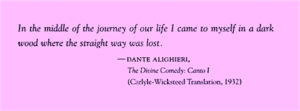by Jack El-Hai, Wonders & Marvels contributor
Leaf through the opening pages of a book of popular history, and there’s a good chance you’ll encounter an epigraph. Does anyone find value in them?
Some of the history writers I most admire — Erik Larson, Harriet Washington, and Diana Preston, to name a few — use epigraphs to introduce their works, but over the years I’ve grown skeptical that epigraphs engage readers, effectively use the valuable real estate that makes up the first pages of any book, or serve any purpose other than showing how resourceful authors are in tracking down literary quotations related to their subject matter.
I have to admit that I once used an epigraph. To introduce my book The Lobotomist: A Maverick Medical Genius and His Tragic Quest to Rid the World of Mental Illness, I drew from no less than William Shakespeare to include these lines from Macbeth:
Canst thou not minister to a mind diseas’d,
Pluck from the memory a rooted sorrow,
Raze out the written troubles of the brain,
And with some sweet oblivious antidote
Cleanse the stuff’d bosom of that perilous stuff
Which weighs upon the heart?
I remember how delighted it made me feel to find a short quotation that so neatly suggested the motivations of my biographical subject, the psychosurgeon Walter Freeman, M.D. In retrospect, though, I now see that Macbeth’s question only superficially hints at Freeman’s inspirations, which were dark and complicated. Shakespeare, I’m afraid, offers no big insights into Freeman’s thinking.
I wonder what my readers take away from the quick dip into seventeenth-century drama to which I subjected them. It now seems that my epigraph did no more than boast that I had a passing acquaintance with Shakespeare and assert by tenuous association that my subject was worthy of the attention of someone as brilliant as the world’s foremost playwright.
Reduced to their essential, most epigraphs are simply high-brow celebrity endorsements, given involuntarily by the celebrities who wrote them. “Just as a painting is viewed with greater respect if the canvas bears the name of a distinguished artist,” the archaeologist Ivor Noël Hume wrote, “and as an oft-voiced plan is suddenly adopted when heard from the mouth of a costly consultant, so authors seek stature for their paltry thoughts by quoting someone else.” (And in quoting Hume here, I’m guilty as well.)
Epigraphs make the author feel good, but few deliver significant information, context or even entertainment to readers, who are likely unfamiliar with the subject at hand. I have not included any in the books I published after The Lobotomist. It’s more sensible to use those valuable opening pages to get right into the story and capture the reader’s or browser’s interest from the start.
That means also eliminating or moving those often insufferable prologues, introductions, and acknowledgments that some authors choose to begin their books with, but I’ll spare you that discussion for another time.

